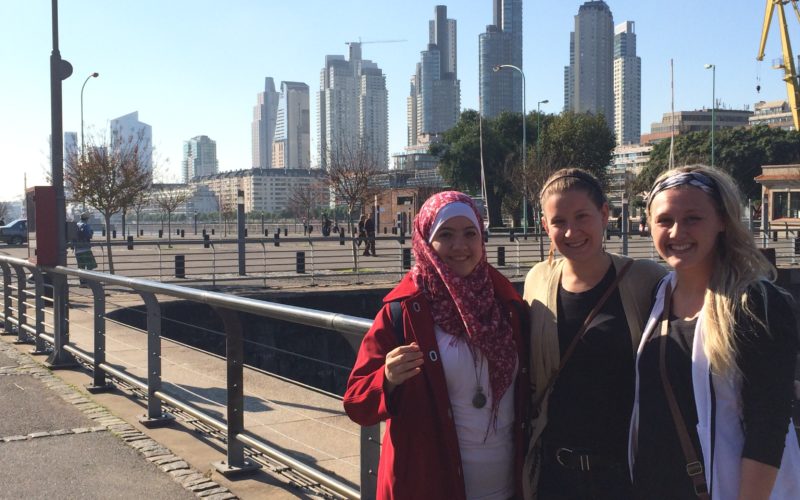Abeer in Argentina
Studying abroad in Buenos Aires has got to be one of the best things I have ever done. In the 5 weeks that I spent in this wonderful South American country, I have been to so many places (Buenos Aires, Iguazú and Tigre) and I have learned so many things. I would like to take a moment to share it with you.
Mate
Mate (mah-tay) or yerba mate (sher-ba mah-tay) is a drink sort of like tea that is a staple in Argentina. It is bitter and is an acquired taste. It is served hot but not with boiling water. It is an interesting taste. Argentines are addicted to it the way most Americans are addicted to coffee. The first time I had it was actually captured on camera. I made a picstitch and will share it.

Misiones Province and Iguazú
My study abroad program, Sol Education Abroad, provided us with an excursion to the Misiones Province of Argentina.
Iguazú was the city we visited in the Misiones Province. Between Buenos Aires and Iguazu is a 14 hour bus ride. Yikes! But what made this ride tolerable was the shear fact that it was more comfortable than an airplane. How is that? The seat reclined all the way back and there was foot rest, and the seat came with a pillow and blanket. We were also served dinner and breakfast (it was not too bad) and our choices of coffee, tea or mate (duh, we are in Argentina).

Tea Farm
Once we got to Misiones, we were escorted to a tea farm where breakfast awaited us. The farm was gorgeous and the group and I took a walk around the area.


Iguazú
The next day, we went to Iguazú National Park. It was created in 1935. Argentina built its park system off of the United States’. This park is located on the natural border between Brazil and Argentina. The waterfall there is called Gargantua del Diablo, meaning the Devil’s Throat. It is absolutely stunning! It must be 3-4X larger than Niagra Falls. None of these pics can truly do it justice.

We had the option of paying 220 Argentine Pesos (about 22 USD) to ride a boat and get closer to the falls. How could I say no? The captain would speed toward the falls and at the last moment swerve or break right in front of it. With the mist, the speed and the proximity; it literally took my breath away.

Guariní
The next day we visited a Guariní village. The Guariní are the native people of Northern Argentina. They showed us the traps they have for animals and the local bi-lingual school (Guariní and Spanish). The children sang us a song and we were encouraged to take photos with them, but it was awkward. It felt as if they were on display for us. Their attitude towards us was apathetic, but the younger children were excited to speak with us. It was very uncomfortable and I felt like I was taking advantage of them because of their indigenous-ness, but it was part of the program.


Estancia Santa Susana
The First Time I Road a Horse
I never rode a horse before, the only thing that I rode similar to it was a donkey. I went to a ranch about an hour outside of Buenos Aires, where we all rode horses and ate the finest asada (barbeque). I think that being raised in Brooklyn, somewhere so urban, riding horses is not a thing. The closest I have ever been to a horse is in Central Park, where there are horse carriages, but I never road it.

We then watch the gauchos (cowboys) play a game where they place a small metal stick into steel rings that are mounted over a gate while standing on a horse. Get on their level



Teatro Colón
The Colon Theater (or Teatro Colón) is the most elegant buildings in all of Buenos Aires, if you ask me of course.
It was built in the 1920’s during the age of Decadence and it’s one of the most European looking structure. It oozes in gold and Venetian and French architecture.



They say the acoustics are the best in the world, Luciano Pavarotti said that they were “too perfect” because it can even catch the mistakes one makes on stage and in the orchestra.
My friends and I decided that we would watch an opera there, Requiem for a Nun, unfortunately it was in English. Their were Spanish subtitles and they gave me more insight into the plot than did the singing.

We paid $50 Argentinian Pesos for each ticket, which comes out to less than $5 USD. The ticket says “Cazuela de pie-solo mujeres” which means that we do not get real seats, but we stand on foot and this section is for women only. We did not know this when we bought the tickets. We sat on our bottoms. There was a porteña (an Argentine name for women from the Autonomous City of Buenos Aires) who brought a little folding chair. I wish someone had shared this idea with me.


World Cup
Plaza de San Martín
Buenos Aires did a great job with providing morale for the game (Argentina"s team made it to the final game, but was beat by Germany). In a Plaza San Martín, in the heart of BA, they put in a large television screen where everyone can go and watch the games. The biggest crowd came in for the games played by La Selección, Argentina's national team. To be in the crowd when they scored a goal was an overwhelming feeling of camaradarie and excitement.



